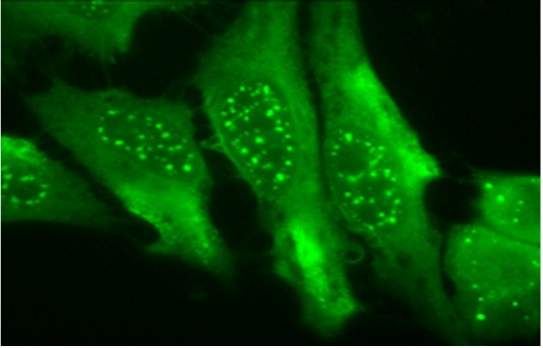Anti-Heme Oxygenase-1 Antibody (Clone 1F12-A6)
Anti-Heme Oxygenase-1 Antibody (Clone 1F12-A6)
Product No.: 13061
- -
- -
Clone 1F12.A6 Target Heme Oxygenase-1 Formats AvailableView All Product Type Monoclonal Alternate Names HO-1, EC 1.14.14.18 Isotype Mouse IgG1 Applications ELISA , WB |
Data
- -
- -
Antibody DetailsProduct DetailsReactive Species Bovine ⋅ Human ⋅ Mouse Host Species Mouse Immunogen Synthetic peptide corresponding to aa 1-30 of human HO-1. Product Concentration 1.0 mg/ml Formulation PBS, pH 7.4. State of Matter Liquid Product Preparation Purified by Protein G affinity chromatography Storage and Handling This antibody is stable for at least one (1) year at -20°C. Avoid repeated freeze-thaw cycles. Regulatory Status Research Use Only Country of Origin USA Shipping Next Day 2-8°C Applications and Recommended Usage? Quality Tested by Leinco ELISA: use at 1ug/ml with HO-1 on the solid phase.
Immunoblotting: use at 0.5-1ug/ml. A band of ~32kDa is detected. Immunofluorescence: use at 5-10ug/ml Positive control: Human cell line lysates such as A431, A549, HeLa, HepG2, Jurkat, or MCF7. These are recommended concentrations. Enduser should determine optimal concentrations for their applications. Each investigator should determine their own optimal working dilution for specific applications. See directions on lot specific datasheets, as information may periodically change. DescriptionDescriptionSpecificity This antibody recognizes human, mouse, and bovine HO-1. It does not cross-react with HO-2. Background Heme oxygenase is a key enzyme responsible for the degradation of heme into biliverdin, free iron, and carbon monoxide (CO). Three isoforms have been identified: HO-1, HO-2, and HO-3, with HO-1 and HO-2 being the predominant forms in mammals. HO-1, also known as heat shock protein 32 (Hsp32), is highly inducible in response to oxidative stress, pro-inflammatory cytokines, heat shock, and various other stress-related stimuli. Deficiency in HO-1 has been associated with impaired cellular stress responses, increased inflammation, endothelial dysfunction, enhanced susceptibility to atherosclerosis, and growth abnormalities. The upregulation of HO-1 is widely recognized as a critical cytoprotective mechanism, helping cells counteract oxidative damage and maintain homeostasis under stress conditions. Function Heme oxygenase cleaves the heme ring at the alpha methene bridge to form biliverdin. Biliverdin is subsequently converted to bilirubin by biliverdin reductase. Under physiological conditions, the activity of heme oxygenase is highest in the spleen, where senescent erythrocytes are sequestrated and destroyed. Exhibits cytoprotective effects since excess of free heme sensitizes cells to undergo apoptosis. NCBI Gene Bank ID UniProt.org Research Area Enzymes References & CitationsTechnical ProtocolsCertificate of Analysis |
Formats Available
 Products are for research use only. Not for use in diagnostic or therapeutic procedures.
Products are for research use only. Not for use in diagnostic or therapeutic procedures.




